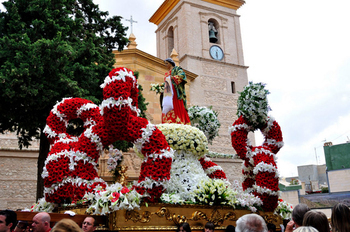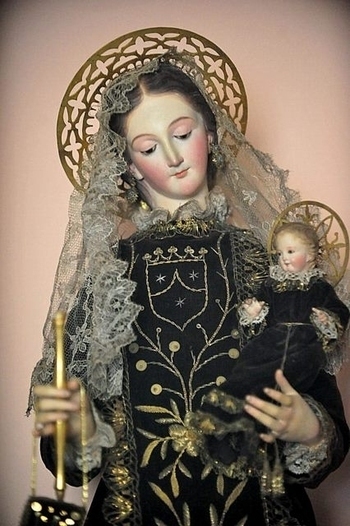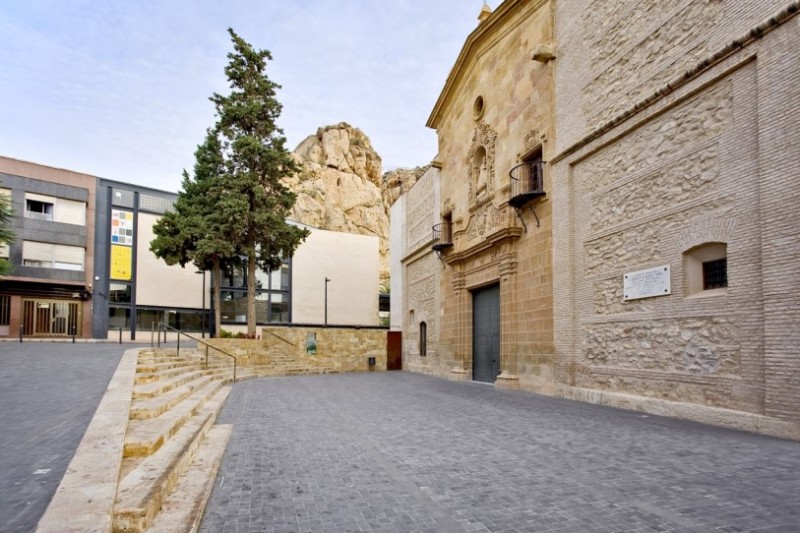The church of San Lázaro Obispo in Alhama de Murcia

The church of San Lázaro Obispo Alhama de Murcia, hours of service
The church of San Lázaro Obispo is built on the remains of an ancient Christian church, which in turn was possibly built over the old mosque, a logical conclusion given the proximity of the thermal baths next door and the part played in the daily religious practices of cleansing before prayer.
For centuries after the departure of the Moors, the site was one of pilgrimage for those seeking the blessing of the curative waters at the baths, which were believed to heal skin disease and leprosy. Today the baths can still be viewed, with both Roman and Arab baths excavated and housed within the Los Baños Archaeological Museum.
The first documented evidence of the church dates back to 1390, when it is mentioned as being under the protection of San Lázaro, and a document of 1479 makes mention of it being a centre for pilgrimage due to the healing waters issuing from the earth nearby.

In the year 1525 the church would have been a very modest and simple construction, but this changed when the Marquises de los Vélez granted a licence for the sale of pasture land in Torreblanca (Totana) and put the money to use amplifying and embellishing the chuch. The Marquises de los Vélez were one of the richest and most powerful families in the history of the Region of Murcia, and were responsible for the construction of many buildings and churches throughout the region, one of their most impressive legacies being the chapel of Los Vélez in Murcia Cathedral, and they were also responsible for the castle which stands on the hill overlooking Alhama.
By the late 17th century, though, parish chronicles reveal that expensive repairs were being required on an almost constant basis, and eventually in the first half of the 18th century the church of San Lázaro was enlarged and rebuilt in the baroque style. Particularly impressive is the simple, elegant façade, which is divided into two main panels – the main doorway was completed in 1747 - while the interior consists of a single nave with an arched roof , with semi-circular windows and a four sided dome over the altar.

The doorway is divided into two levels, the first of which consists of two Tuscan columns topped by a smooth architrave adorned with flowers and angels. On top are two pinnacles and a niche containing the sculpture of Nuestra Señora de Gracia. The ornamental acroterion contains the figures of San Lázaro in the centre and his sisters Santa Marta and Santa María
Other notable achievements were the construction of a new sacristy between 1728 and 1730 and the commissioning of an altarpiece from Juan de Uzeta in 1741. During this period the church tower was also completed.
Neo-classical flourishes were added in the late 18th and early 19th centuries under the supervision of the architect Lorenzo Alonso, and can be seen in the Communion Chapel (or "Capilla del Rosario") and the niche where the image of San Lorenzo is placed.
Religious art
 Most of the religious figures in the church are modern, the originals having been stolen or destroyed during the Civil War (1936-39), although there are two interesting 18th century pieces which survived the conflict tucked away in the private area of the church. These have been attributed to pupils of the master sculptor Francisco Salzillo, although they are not the work of the master himself: to see them, arrive before or after Mass and ask!
Most of the religious figures in the church are modern, the originals having been stolen or destroyed during the Civil War (1936-39), although there are two interesting 18th century pieces which survived the conflict tucked away in the private area of the church. These have been attributed to pupils of the master sculptor Francisco Salzillo, although they are not the work of the master himself: to see them, arrive before or after Mass and ask!
Many of the “new” sculptures are the work of José Lozano Roca (1899-1972), who created the figure of San Lázaro Obispo himself in 1945: this now stands above the main altar, and over the next five years the same artist created the processional figures of San Juan, Jesús Nazareno and others. Another contributor was the post-war sculptor José Sánchez Lozano (1904-1995), who created the figures of the Inmaculada Concepción (1944) and La Dolorosa.
But the figure of the Virgen del Rosario, one of the patrons of Alhama was commissioned from the Valencia artist José Capuz and donated for the Communion Chapel by the wealthy businessman Lorenzo Rubio and his wife in 1942. The same man, incidentally, owned the land which is now the Parque de la Cubana in the town centre.
In addition to these wooden sculptures, the stone figure of Nuestra Señora de la Gracia holding the infant Jesus in her left arm in a niche on the main façade, which was devoted by Rodrigo Fuertes Valero can also be seen.

Work on the main altar screen by Francisco Ganga began in 1784, but the only part which remains is the top, featuring the image of Nuestra Señora de la Gracia surrounded by clouds and angels. The rest was replaced by a new golden piece in 2004, after the original was another victim of the Civil War.
The square to the side of the church is built over the original cemetery, as early Christians preferred to be buried as close to the House of God as possible. Have a look at the imposing door - the date of its commission can be seen punched into the metal.
The church is the starting point for several of the processions during Semana Santa (Easter Week), and provides an atmospheric and intimate setting for concerts and theatrical representations, all forming part of Alhama´s annual cultural and traditional activities.
Click here for a full history of Alhama de Murcia.
Mass times
Summer (July and August): Monday to Saturday 20.00, Sundays 10.00 and 12.00.
Winter (September to June): Monday to Saturday 19.00, Sundays 10.00, 12.00 and 19.00.
For more local information in English relating to the municipality of Alhama de Murcia, including news and forthcoming events, visit the home page of Alhama Today.



 Welcome To
Welcome To Alhama de Murcia
Alhama de Murcia


 Welcome To
Welcome To Alhama de Murcia
Alhama de Murcia


 Welcome To
Welcome To Alhama de Murcia
Alhama de Murcia


 Welcome To
Welcome To Alhama de Murcia
Alhama de Murcia






 Most of the religious figures in the church are modern, the originals having been stolen or destroyed during the Civil War (1936-39), although there are two interesting 18th century pieces which survived the conflict tucked away in the private area of the church. These have been attributed to pupils of the master sculptor Francisco Salzillo, although they are not the work of the master himself: to see them, arrive before or after Mass and ask!
Most of the religious figures in the church are modern, the originals having been stolen or destroyed during the Civil War (1936-39), although there are two interesting 18th century pieces which survived the conflict tucked away in the private area of the church. These have been attributed to pupils of the master sculptor Francisco Salzillo, although they are not the work of the master himself: to see them, arrive before or after Mass and ask!



